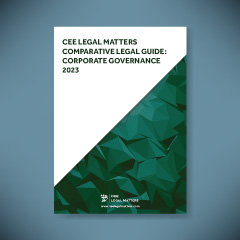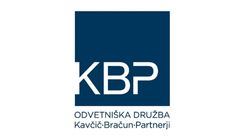Contributed by Kavcic, Bracun & Partners.
1. Corporate Structure Of The Companies
1.1. General Legal Framework
In the Slovenian legal system, companies and their corporate structure are primarily regulated in the Companies Act (Zakon o gospodarskih druzbah, ZGD-1, Official Gazette of Republic of Slovenia, nr. 65/09 as amended). Two of the most common legal forms of companies that are used for running or real estate (RE) business in Slovenia are limited liability companies (druzba z omejeno odgovornostjo – d.o.o.) and joint stock companies (delniska druzba – d.d.). Thus, in this short guide, we will mainly focus on those two forms of legal entities.
Each company as a legal requirement has to have the following corporate bodies: (i) a legal representative that can represent the company in legal transactions – the Management Body, (ii) a Supervisory Body (not always mandatory), and (iii) a Shareholders’ Assembly. There is no difference in the setup that would depend on the size of the company, but it depends on the legal form of the entity.
The Management Body of a limited liability company typically includes one (or more) legal representatives (i.e., a director of the company) that governs the company, makes decisions, and adopts resolutions on the conduct of its business. If there is more than one director, they may each represent the company in legal transactions solely or jointly. The number of directors and mode of representation is decided by the shareholder(s) and set out in the Articles of Association or Statute (in the case of a single shareholder company). If it is envisaged in their incorporation documents limited liability companies can have a Supervisory Board (except for companies of public interest where the establishment of a Supervisory Board is mandatory). The provisions of the Companies Act that govern a Supervisory Board of joint stock companies are applied mutatis mutandis. The Shareholders’ Assembly includes all shareholders, which have voting rights, and who decide on the running of the company at meetings. In a single shareholder limited liability company instead of the Shareholders’ Assembly, the shareholder governs through the adoption of resolutions that must be entered into the Book of Resolutions (either in electronic or paper form).
On the other hand, joint stock companies have more stringent requirements for their corporate structure in accordance with the Companies Act. Shareholders can choose between a one-tier or two-tier system. In a one-tier system, there is one corporate body, the Board of Directors that is responsible for supervising and managing the company. Although it is not a requirement, the Executive Directors may be selected among the Board of Directors’ members, who then handle the day-to-day operations of the company and perform management duties. In a two-tiered structure, bodies consist of the Supervisory Board, which must be appointed by the majority of the shareholders, and the Management Board. Supervisory Board appoints and supervises Management Board, which is responsible for the company’s management. A Shareholders’ Assembly is mandatory and it must be convened at least once a year. There are detailed rules that must be followed for the convocation and conduct of the Shareholders’ Assembly.
In addition, in either form, a “procurator” can be appointed. This is a very common practice in Slovenia. Pursuant to the Companies Act, all actions that are within the authority of the legal representatives may be carried out by the procurator, apart from disposing or encumbering RE and granting powers of attorney for the legal representation in the court. The limitations regarding RE assets are very useful if the foreign investor wants to position a certain person to run the company’s day-to-day business without the power to dispose of or encumber any assets. The procurator’s representational authority may be further limited (by way of joint representation) in addition to any other restrictions that are entered in the court register.
The Companies Act requires a minimum of one shareholder for the establishment of both a limited liability company and a joint stock company. And in the case of limited liability without specific permission by the minister responsible for economy there cannot be more than 50 shareholders. There are no restrictions regarding local residency or nationality requirements for shareholders in the Slovenian legal system. However, the Companies Act does include the following prerequisites that a potential shareholder has to fulfill: (i) a record of their criminal history has to be provided, certifying they have not been convicted of a crime against the economy, social security, legal transactions, property, the environment, or natural resources; (ii) proof they have no outstanding tax debt and have not been published on the list of tax debtors in the last 12 months, and; (iii) a confirmation that they have not received two (or more) tax or employment inspection fines in the previous three years for illegal employment or payment for work, nor should they own at least a 25% stake as a shareholder in the company that has received the aforementioned fines.
The shareholders of a limited liability or joint stock company are generally not liable for the business of the legal entity. However, the Companies Act includes a specific provision regarding the possibility of “lifting the corporate veil.” According to this provision, shareholders can be liable for the obligations of the legal entity in the following scenarios: (i) if they have abused the company as a legal person in order to attain an objective that is forbidden to them as individuals; (ii) if they have abused the company as a legal person, thereby causing damage to their creditors or creditors of the company; (iii) if, in violation of an act, they have used the assets of the company as a legal person as if they were their own personal assets; or (iv) if, for their own benefit or for the benefit of some other person, they have reduced the assets of the company, when they knew or should have known that the company would not be capable of meeting its obligations to third parties.
In accordance with the Companies Act, the criteria for differing between micro, small, medium, and large companies, are: (i) the average number of employees in a business year, (ii) the net revenue from sales, and (iii) its assets’ value. To be counted as one of the abovementioned types of companies, a company has to meet two out of three criteria for two consecutive business years.
The criteria for a micro company are: (i) the average number of employees in a business year does not exceed ten, (ii) the net revenue from sales does not exceed EUR 700,000, and (iii) its assets’ value does not exceed EUR 350,000.
The criteria for a small company are: (i) the average number of employees in a business year does not exceed 50, (ii) the net revenue from sales does not exceed EUR 8 million, and (iii) its assets’ value does not exceed EUR 4 million.
The criteria for a medium company are: (i) the average number of employees in a business year does not exceed 250, (ii) the net revenue from sales does not exceed EUR 40 million, and (iii) its assets’ value does not exceed EUR 20 million.
A large company is one that does not meet the criteria of the above three, or in other words, it exceeds the numbers (criteria) of the above three (micro, small, medium).
1.2. The Function of the Supervisory Board
The main function of the Supervisory Board is to ensure that the interests of the shareholders are represented, with that in mind they always act for the good of the company. Pursuant to the Companies Act, the Supervisory Board’s main function is to supervise the conduct of the business of the company. The Supervisory Board in a joint stock company appoints and recalls Management Board members. The Supervisory Board may inspect and examine the books and documents of the company and its treasury, the securities, stocks of goods, and other property. The Supervisory Board may also request from the Management Board any information necessary for the exercise of their supervision.
The members of the Supervisory Board must act with the legal standard of diligence of a conscientious and honest businessperson and safeguard the trade secrets of the company. In doing so, the members of the Supervisory Board must comply with the recommendations of best practices and codes of conduct. The duty of diligence includes the duty to participate personally in the work of the Supervisory Board and the duty to ensure that the Supervisory Board acts properly and in a timely manner. In addition, other duties include the duty to request reports and information from the Management Board, the duty to assess the suitability of candidates for the Management Board, the duty to monitor the work of the Management Board and its members, and, above all, draw immediate attention to any irregularities that may occur in the company.
In accordance with the Financial Operations, Insolvency Proceedings, and Compulsory Dissolution Act (Zakon o financnem poslovanju, postopkih zaradi insolventnosti in prisilnem prenehanju, Official Gazette of RS, no. 176/21 as amended) the Supervisory Board has to regularly verify whether the company is solvent in the short and long-term viability and that the management complies with the rules included in the beforementioned Act which regulates the long-term financial solvency of the company. The members of the Supervisory Board are in the case of the mentioned duties also jointly and severally liable to the Company for any damage suffered by the Company because of a breach of their duties.
As explained above, all participants in the corporate governance of the company have to act with diligence and conscientiously while safeguarding the trade secrets of the company. Their duties have to be performed in the best interest of the company and its shareholders. As mentioned, the Board members are jointly and severally liable to the companies if they violate their duties, unless they can prove that their duties were fairly and conscientiously fulfilled.
1.3. The Function of the Executive Board
The Executive Board being understood as the management body can take different forms. Limited liability companies in Slovenia are not required to have a board as a company’s body but can have a single director or more directors. In a one-tier system of governance of a joint stock company, the Board of Directors may have both executive and non-executive directors (as explained in Section 1.1.). For public joint stock companies, the Companies Act mandatorily structures the Board of Directors into executive and non-executive directors, but this does not apply to non-public companies. In a two-tier system, the Management Board performs the executive function.
Most of the responsibilities of the management bodies are mandated in the Companies Act and other applicable legislation, while others may be included in any other contract governing the manager’s relationship with the company.
There are some legally prescribed requirements that the members of the company’s bodies that function as legal representatives of the company have to comply with if they want to be appointed at their function. In this case, a natural person cannot be a member of any of the corporate governance bodies if a natural person: (i) is already a member of the company’s supervisory body or; (ii) has been found guilty of a crime affecting the economy, social security, legal transactions, property, the environment, or natural resources (the appointment of such a representative is prohibited for five years after the person was convicted in a final judgment or two years after imprisonment), (iii) is subject to a preventive measure prohibiting them from practicing their profession (during the duration of this prohibition), and (iv) has been found guilty in a final judgment as a member of a management or supervisory body of a company for which bankruptcy proceedings had been initiated and is therefore required to pay creditors compensation.
1.4. Conflicts of Interest and Related Party Transactions
The Companies Act includes provisions that govern the conflict of interest of members of management or supervisory bodies, the procuration holder, the executive director and the manager of a public limited company, a member of the supervisory board and the procuration holder of a limited liability company. The before mentioned persons have to avoid any conflict of their own interests or duties with the interests or duties of the company which are conducted or supervised by that same person. The Companies Act also provides the definition of a conflict of interests which says: “the conflict of interests of a person exists when impartial and objective performance of duties, or decision-making related to carrying out their function, is jeopardized due to the inclusion of personal economic interest, the interest of family members or due to special favor or any other interests connected to any other natural or legal person.”
If a conflict of interest occurs, the person that is in conflict of interest has to notify it in writing the body of which they are a member, as well as the supervisory body, no later than three days. If the company does not have a supervisory board, they have to inform the shareholders at the next Shareholders’ Assembly.
The Companies Act also includes provisions governing the transparency and approval of related party transactions. Concluding transactions with related parties refers to a wide circle of related companies and individuals as defined in the International Accounting Standards (e.g., associated undertakings, joint ventures, persons in the management of the company, etc.). In the case of related party transaction, the approval (i.e., consent) of the Supervisory Board is required for the conclusion of a contract between members of management, supervisory bodies or executive directors and parties related to them (including family relations) and the company, in which they hold corporate functions.
1.5. Legal Framework for Large Companies
Please see Section 1.1.
2. Corporate Governance Framework
2.1. Transparency and Public Disclosures
A company has to provide certain information to the Agency of the Republic of Slovenia for Public Legal Records and Related Services (AJPES). After the information is provided, the AJPES publicly posts the following information: (1) (long and shortened) name of the company, (2) registered office, (3) business address, (4) organizational form of the company, (5) share capital (and a number of shares, if it is a joint stock company, or company’s shareholders if it is limited liability company), (6) Supervisory Board members (if it has one), (7) legal representatives (including Board of Directors), (8) tax identification and registration number, (9) Articles of Association or Statute, and (10) whether there is a winding-up process, the legal fact of the process and name of the process (e.g., liquidation, bankruptcy). Additionally, every company has to send to the AJPES its annual report within three months (for small and micro companies) or eight months (for other companies) after the end of the business year. The AJPES then publishes annual reports on its website so that they are freely accessible to the public. The eight-month deadline applies to the consolidated annual report as well.
If a company has a website, at least the following information must be made available: (1) name of the company, (2) registered office, (3) registration number, (4) share capital (and the amount of called-up capital if there is any), and (5) if there is a winding-up process, the legal fact of the process and name of the process (e.g., liquidation, bankruptcy).
The decisions of the Shareholders’ Assembly in principle do not need to be publicly disclosed. However, if a company is publicly traded on an organized market, it has to publicly disclose the voting results two days after the Shareholders’ Assembly. Further, if shareholders vote on an exceptional decision, they can also demand public disclosure of the vote, if they surpass 10 percent of the shares in the vote.
The decisions adopted by the Supervisory Board do not need to be publicly disclosed and are in practice not published unless such requirements arise from the stock exchange disclosure rules for specific decisions (for listed companies).
2.2. Public Authorities Responsible for Monitoring Corporate Governance
There is no public authority responsible for monitoring the standards.
The corporate governance framework in Slovenia consists of a combination of legislation (i.e., the Companies Act), codes, and best practice recommendations. Corporate governance codes are voluntary, and companies can implement them and comply with them at their own discretion. However, if the company chooses to comply with a certain code, then its application becomes mandatory for such a company.
There are many different corporate governance codes in Slovenia, and once adopted, they form a part of the internal procedures of the adopting firm and must be made public. For example, the Slovenian Chamber of Commerce issued the Corporate Governance Code for Unlisted Companies, which can be used by companies if they want to. The Slovenian Directors’ Association (SDA) is a professional, not-for-profit, and non-governmental organization that includes the members of Supervisory Boards, Directors, and other stakeholders of corporate governance, who have inter alia adopted guidelines and codes of corporate governance. Since the SDA plays a leading role in education, certification, and development of corporate governance and best practice for Boards in Slovenian companies and their reputation, many of their codes or recommendations are implemented by the companies. However, their acts are not legally binding but are useful as guidelines of exemplary business conduct.
In addition, legal entities that must be audited are required to adhere to a governance code when preparing the so-called governance statement, which is an integral part of the companies’ annual report.
2.3. ESG
The company’s dedication to ESG standards is treated as a part of the non-financial aspect of the business. A company that is subject to public interest and has more than 500 employees on a cut-off date in the balance sheet, has to include a statement of non-financial operations in the consolidated annual report. The statement of the non-financial aspect of the business includes information for the understanding of development, success, and position of the company and the impact of its activities, and contains at least information on environmental matters, social and human resources, respect of human rights and matters in relation to the prevention of corruption and bribery. The statement further includes: (i) a short description of the business model of the company, (ii) a description of the company’s policies regarding the abovementioned matters, (iii) the results of such policies, (iv) the main risks in relation to the abovementioned matter, and are intertwined with the business of the company, and (v) crucial non-financial performance indicators.
The non-financial statement must be revised by the auditor. The auditor checks whether all information that was disclosed is in line with the law and a statement if there are any uncertainties.
2.4. Internal Controls and Fraud Measures
Companies for which auditing is obligatory must include a corporate governance statement in their business reports. The report must include a description of the principal characteristics of internal controls in connection with the financial reporting procedure.
In disclosing the internal control system and risk management the consolidated business report presents only the main characteristics of the internal control systems in the consolidated business report. The Audit Committee monitors the efficiency and effectiveness of the company’s internal control and internal audit. Further, the auditor must cooperate with the Audit Committee and notify them if any major issues relating to the audit of the annual report, in particular regarding significant deficiencies in internal control.
The Companies Act provides certain rules on the work of an internal audit body. But the most important act regulating auditing is the Auditing Act (Zakon o revidiranju, Official Gazette of RS, no. 65/08 as amended) which confers power to adopt certain rules on (internal) auditing to a Slovenian Audit Institute. The Institute adopted a Codex of Internal-Auditing Principles (soft law) along with other core principles for professional practice in auditing, including the principle of internal audit independence.
3. Shareholder And Board Committees
3.1. What Committees Are Prescribed by Law?
There is only one prescribed committee by law: an Audit Committee. But the Supervisory Board (or Board of Directors) may choose to establish more committees such as Nomination Committee or Remuneration Committee.
The committees may not decide on the questions reserved for the Supervisory Board, but they can prepare decisions and advise on the respective matter. Each committee consists of at least three members: a president who must be a member of the Supervisory Board and at least two other members, experts in a concerning field. A committee must meet at least once every three months unless Statute provides otherwise. A Committee reports to the Supervisory Board on the matters they discussed. Remuneration for the other committee members, who are not Supervisory Board members, is decided on by the decision of the Supervisory Board.
3.2. What Committees Are Mandatory for Large Companies?
The Companies Act provides for a mandatory Audit Committee for companies that are subject to the public interest (e.g., they have to prepare consolidated annual report) or in the case of the Board of Directors if the employees demand their right to take part in the company bodies.
The Audit Committee is appointed by the Supervisory Board or Board of Directors, as the case may be, and consists of at least one independent expert who is capable of accountancy or revision. Other members may be members of the Supervisory Board or Non-Executive Directors of the Board of Directors, as the case may be, as long as they are capable of working in the area of revision.
3.3. Remuneration of Supervisory and Executive Board Members
The Companies Act is the main source (mandatory law) of rules for the remuneration of board members. In addition, the Codex of Professional Ethics of the Slovenian Directors’ Association, the Guidelines for the functioning of the Management Boards, and the Corporate Governance Codex for Non-Public Companies (soft laws) all provide certain additional aspects of the remuneration policies in the companies. If a company’s shares are publicly traded or it is provided in the Statute or Articles of Association, it must adopt a Remuneration Policy for the Supervisory Board and Board of Directors. A Remuneration Policy must be confirmed at a Shareholders’ Assembly and revised at least every four years. This policy must include all information about the fixed and variable aspects of remuneration.
Members of a Board of Directors may by law receive the following payments for their work: a salary, benefits (e.g., a car, a mobile phone), reimbursement of expenses (e.g., business trip, overnight stays, education), a business performance award, a share of profits, (the amount of remuneration is normally provided as a percentage of yearly profits), an insurance premium, a commission, a severance grant, and other additional remunerations. The payments must be in an appropriate proportion to the Board of Directors member’s tasks and the company’s financial situation. However, the remuneration may be reduced by the decision of the Supervisory Board if the business of the company deteriorates to the extent it threatens the economic position of the company or it could cause damage to the company. Additionally, the Supervisory Board may request a proportional return of already paid bonuses for business performance under certain conditions.
Supervisory Board members can be paid if the Statute/Articles of Association or Shareholders Meeting determine that. If Supervisory Board members are paid, the payment has to be in an appropriate proportion to their tasks and the company’s financial situation.
Except for the state-owned companies there are in principle no limitations on the amount of remuneration that can be agreed.
Companies are in principle not required to set up a Remuneration Committee.
Normally, the Supervisory Board and Board of Directors’ remunerations do not need to be publicly disclosed. But, if a company’s shares are publicly traded or it is provided in Statute or Articles of Association, a company (Board of Directors) must prepare a clear and concise report on remuneration, including all benefits of any sort, which were given to the Board members in line with the Remuneration Policy. The report must be revised by the auditor and published on the company’s website once it is adopted by the Shareholders’ Assembly.







